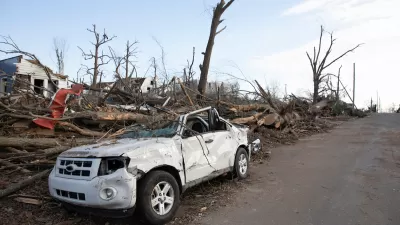Sandy has displaced thousands of families, while leaving many without hot water or heat. Officials are concerned cold temperatures will increase the number of families seeking shelter, and are asking NYC landlords to help house them in vacant units.
"You really need to help out," Shaun Donovan, the federal Secretary of Housing and Urban Development, told real estate executives in Manhattan last week. The meeting was a first step towards "a White House rebuilding program that President Obama is expected to announce on Thursday in Manhattan for New York, New Jersey and possibly Connecticut," adds Charles V. Bagli. Members of the Real Estate Board of New York, the Rent Stabilization Association and the New York Association for Affordable Housing also met with officials to discuss the possibility of a public-private partnership to help families displaced by Sandy.
The Federal Emergency Management Agency (FEMA) currently provides a monthly rental assistance of $1,800 for up to 18 months. Officials and landlords have discussed "a system by which people who apply to the Federal Emergency Management Agency for housing could be matched with landlords who have vacant apartments," writes Bagli. "The tenants would pay rent directly with a FEMA voucher, or obtain an apartment through an agency like the Red Cross." However, there is concern that assistance from FEMA may only be enough to cover units in Brooklyn and Queens, not Manhattan.
While landlords are open to lending assistance, Bagli notes, they have "raised a series of statutory and legal hurdles that would have to be overcome." These include provisions for short-term tenants and indemnification for apartment damages and forced eviction. "'People want to do the right thing,' said Charles Dorego, senior vice president of Glenwood Management, a major Manhattan landlord, who attended the meetings on behalf of the Real Estate Board. 'But they don't want to inherit a pig in a poke.'"
FULL STORY: U.S. Asks New York Landlords for Vacant Apartments to House Displaced Families

Alabama: Trump Terminates Settlements for Black Communities Harmed By Raw Sewage
Trump deemed the landmark civil rights agreement “illegal DEI and environmental justice policy.”

Planetizen Federal Action Tracker
A weekly monitor of how Trump’s orders and actions are impacting planners and planning in America.

The 120 Year Old Tiny Home Villages That Sheltered San Francisco’s Earthquake Refugees
More than a century ago, San Francisco mobilized to house thousands of residents displaced by the 1906 earthquake. Could their strategy offer a model for the present?

Indy Neighborhood Group Builds Temporary Multi-Use Path
Community members, aided in part by funding from the city, repurposed a vehicle lane to create a protected bike and pedestrian path for the summer season.

Congestion Pricing Drops Holland Tunnel Delays by 65 Percent
New York City’s contentious tolling program has yielded improved traffic and roughly $100 million in revenue for the MTA.

In Both Crashes and Crime, Public Transportation is Far Safer than Driving
Contrary to popular assumptions, public transportation has far lower crash and crime rates than automobile travel. For safer communities, improve and encourage transit travel.
Urban Design for Planners 1: Software Tools
This six-course series explores essential urban design concepts using open source software and equips planners with the tools they need to participate fully in the urban design process.
Planning for Universal Design
Learn the tools for implementing Universal Design in planning regulations.
Clanton & Associates, Inc.
Jessamine County Fiscal Court
Institute for Housing and Urban Development Studies (IHS)
City of Grandview
Harvard GSD Executive Education
Toledo-Lucas County Plan Commissions
Salt Lake City
NYU Wagner Graduate School of Public Service





























